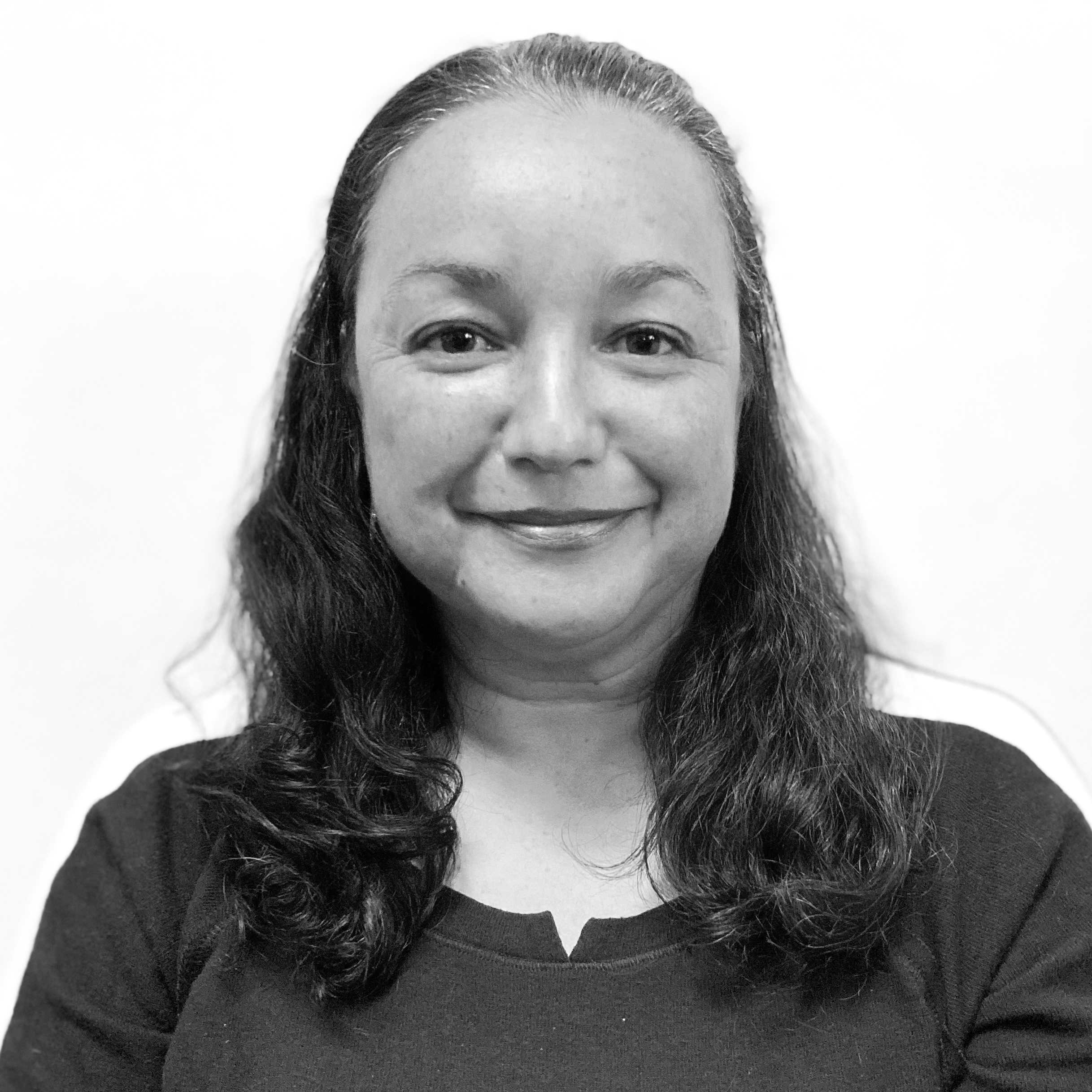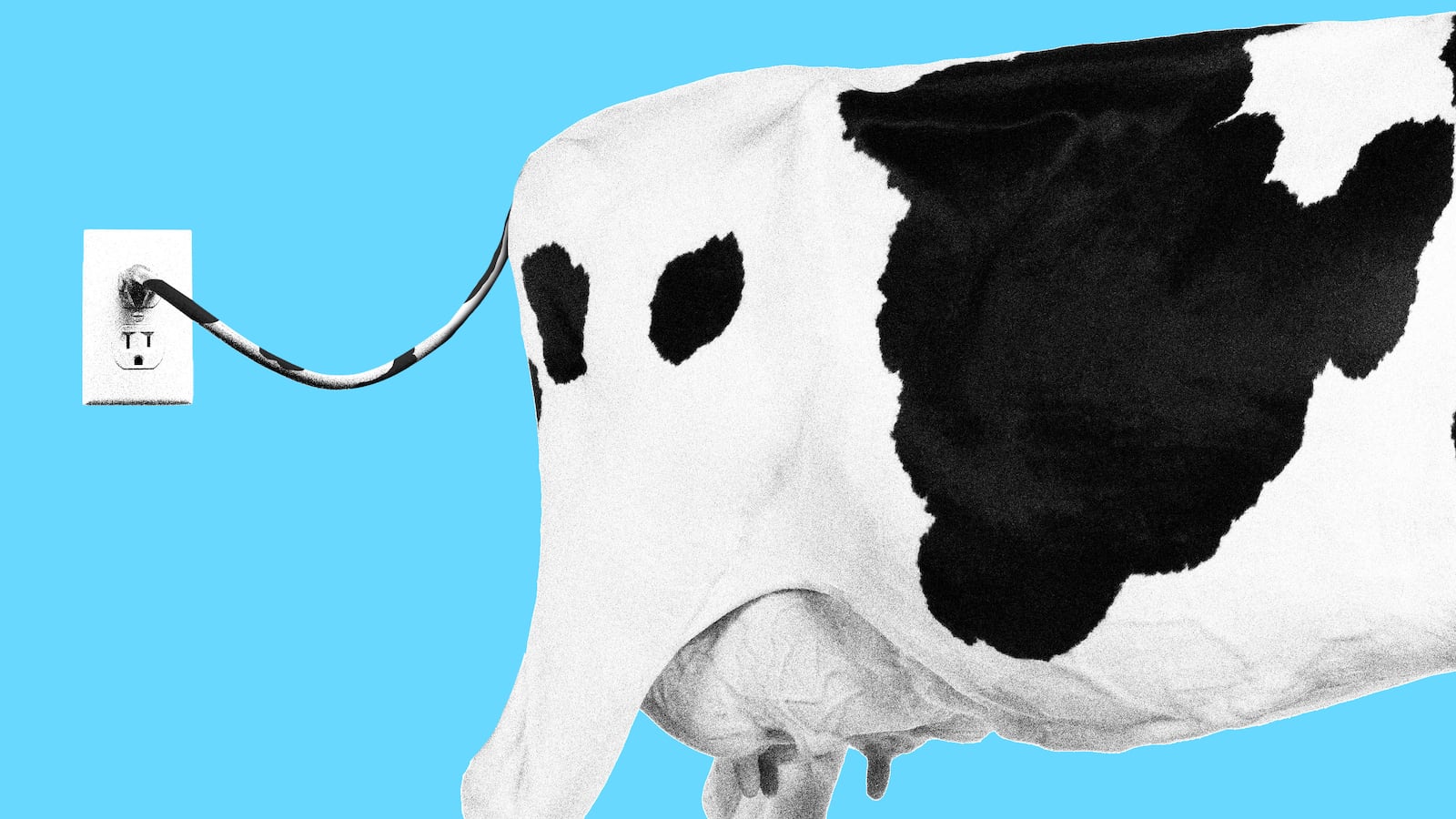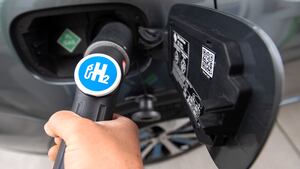It has already proven its worth as a fertilizer and building material, and even as a secret ingredient in Ancient Egyptian ceramics. As it turns out, cow dung might also have a bright future as a plentiful source of clean electricity, thanks to the planet-warming methane it produces.
Few places encompass this potential future better than Bar 20 Dairy, a dairy farm in Kerman, California, which uses methane from cow manure to produce clean electricity with almost zero carbon emissions. It’s the first dairy farm in the U.S. to power its own clean energy “microgrid” using a biogas, and it could be a tantalizing sign of what the future of green energy might look like for companies with access to plenty of methane.
The technology isn’t all that hard to grasp. Manure and waste water from the farm’s nearly 7,000 cows are transported and sifted into a 25-million-gallon rectangular pit in the ground called a digester. The liquid sits for about 30 days while methane gas rises to the top of the closed digester. The gas then gets piped into a skid shifter, which separates the methane from hydrogen sulfide and other impurities. Finally, the methane is piped into fuel cells that harness it to produce electricity with little to no greenhouse gas emissions.
“It’s where Silicon Valley meets the Central Valley,” said N. Ross Buckenham, the CEO of California Bioenergy, a company that operates and builds manure digesters—including the one used by Bar 20 Dairy.
Producing electricity from cow poop (or other forms of agriculture waste like hog manure) is not an entirely new concept. For at least 15 years now, dairy farms from Vermont to Wisconsin have engaged in this kind of small-scale bioenergy production, making enough electricity to power a few hundred homes, and certainly more than enough to keep a large farm running.
The problem is that most of these places use a combustion engine to run the processes that actually make electricity. The green benefits that come from finding a new use for waste are basically wiped out by the greenhouse gasses these engines pump into the air.
This is where fuel cells lend a helping hand, since they don’t spew out carbon dioxide as a byproduct when running the methane-to-electricity reactions. Bar 20 Dairy uses solid oxide fuel cells made by San Jose-based company Bloom Energy. They consist of an anode, a cathode, and an electrolyte that’s sandwiched between two interconnected plates. As methane flows through the anode side and air passes through the cathode side, it causes a chemical reaction in the electrons which produces electricity, with practically zero carbon dioxide byproduct.

Bloom Energy’s fuel-cell system at Bar 20 Dairy. Along with the farm’s solar arrays, the one-megawatt system provides enough electricity to power all of the dairy farm’s needs.
Bloom EnergyThe result is a self-sustaining, clean energy microgrid: something Bar 20 Dairy’s Steve Sheheady and his family have been trying to establish for years.
Sheheady, whose grandfather started Bar 20 Dairy, told The Daily Beast the farm’s microgrid (bolstered by solar panel arrays) is running better than expected. The fuel-cell system, which started operating in October, is expected to produce about 8.5 million kilowatt-hours of power per year, which is equivalent to powering over 750 homes, according to Bloom. Right now, the farm is basically making more power than it’s able to use. Excess power is put back into the local utility’s grid and is used for electric-car charging, according to Sheheady.
“We used to joke about how funny it would be if we could make more money off the poop than the milk,” Sheheady said. “And now we’re essentially here.”
Farms, private firms, health-care facilities, and university campuses are all spending millions to get in on the microgrid movement, lured by the prospect of reducing their energy costs and relying less on local utilities (which have battled chronic power outages due to natural disasters and aging infrastructure). And it’s a worldwide phenomenon: Market intelligence firm Guidehouse Insights estimates that spending on microgrid technology and equipment will reach $110.5 billion globally by 2030. In the U.S., microgrids especially make sense for groups operating in states like California, Hawaii, Massachusetts, and New York, where electricity prices have skyrocketed.
And of course, the sluggish movement by world governments to combat climate change means private parties are willing to forge ahead on their own to find clean, sustainable sources of energy.
This is especially true in California, which has been pushing industries like agriculture to reduce greenhouse gas emissions since 2006. Although carbon dioxide emissions grab headlines, methane is 80 times worse for global warming over a 20-year period than carbon dioxide. About 40 percent of all methane emissions are from the agricultural sector.
Bloom’s fuel-cell installations, which have been purchased by Home Depot, Morgan Stanley, and Caltech, have largely run on natural gas, which burns relatively clean but still results in plenty of greenhouse gas emissions. The company is very excited to finally see its technology being used in a clean energy project like Bar 20 Dairy’s. Sharelynn Moore, Bloom’s executive vice president, told The Daily Beast that the firm also recently started operating a microgrid project for a Silicon Valley firm that is getting methane from a nearby landfill. It is also in talks with several waste and water management companies to tap methane from their treatment facilities to turn into electricity.
“We’re on the cusp of really changing how energy is delivered,” said Moore. As more states mandate the use of green electricity from renewables like solar, wind, and hydro, Moore is hopeful the company’s fuel-cell servers can help close the loop.

Bar 20 Dairy in Kerman, California owns about 7,000 cows. The methane from bovine excrement is used to power fuel cells, which produces clean electricity.
Dairy CaresAs with many climate change solutions, however, high costs will bar many people from these kinds of projects. Bar 20 Dairy has spent about $12.5 million on its fuel-cell system and digester. Sheheady said he received a $3 million grant from the state of California and has applied to receive a $2.4 million rebate. The rest came from a bank loan. It helps that Sheheady’s dairy farm is large, as not all farms will necessarily have access to the same avenues to raise that kind of capital.
But with the early success of Bar 20 Dairy’s fuel-cell system, there are several other California dairies that are interested in developing their own clean energy microgrid. California Biogas has already heard from several that are looking to build out the necessary infrastructure and take independent control of their power needs.
“If you’re going to stay in the dairy business, you’re not going to make it anymore with just dealing with cows because the costs are so high,” Sheheady said. “We might be able to save dairy this way.”
Talk about milking a cow for all it’s worth.






